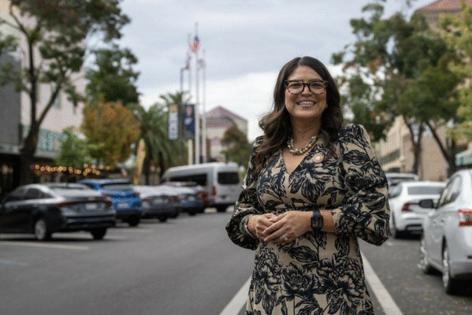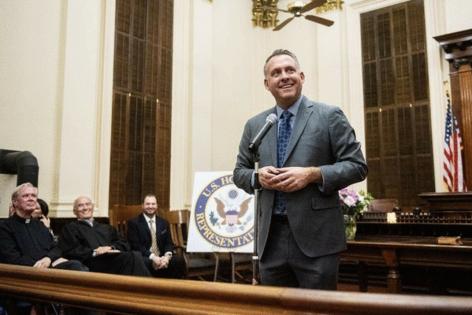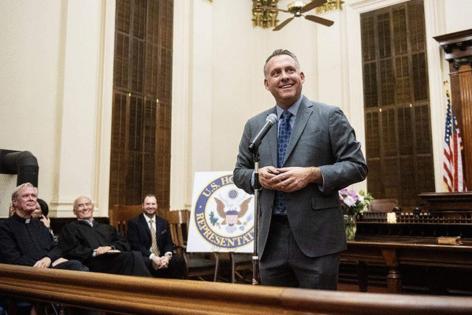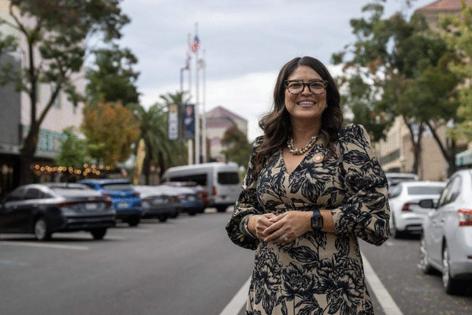Would California's Proposition 50 really flip 2 Central Valley seats? It's a gamble
Published in News & Features
SACRAMENTO, Calif. — Proposition 50 could give Democrats in the southern Central Valley the boost they need to finally oust Rep. David Valadao, R-Hanford, for good.
But in oil-rich and water-poor Kern County, where big industries align with Republicans and many working-class Latinos stay out of politics to preserve their livelihoods, local Democrats acknowledge it will be an uphill climb – even with an advantage from the political gerrymander that California voters are being asked to approve in a Nov. 4 special election – to unseat the six-term congressman and defend the battleground seat moving forward.
“Valadao has been really strong in this district,” Noe Garcia, a regional leader with the California Democratic Party, said in the Bakersfield offices of a domestic workers’ union where he organizes local efforts in support of Prop. 50.
If it passes, the 22nd Congressional District will “swing a few points more blue by removing some of Tulare and Kings Counties. But the work still stays the same,” he said.
Democrats see Prop. 50 as a chance to secure the 22nd and 13th Congressional Districts, neighboring Latino-majority swing districts that span California’s agricultural heartland in the Central Valley and where political parties spend millions every election cycle.
Gov. Gavin Newsom proposed the new congressional map to oust five Republican members of Congress, including Valadao, under new lines that favor Democrats in order to counteract similar measures in Texas and other red states.
There’s just one hitch: Even if the congressional redraw passes, California’s 13th and 22nd districts would remain quite competitive.
In some ways, Newsom is putting the outcome of Prop. 50 – his most high-profile fight yet with President Donald Trump – on voters in a region where he’s not that popular, even among members of his own party.
“Gavin Newsom is a very polarizing figure” in Kern County, which voted overwhelmingly to recall him in 2021, Garcia said. “Even amongst the Democrats here, they don’t see him as the solution.”
The ballot proposition is Newsom’s counterpunch to Texas and other Republican states that have initiated mid-decade redistricting at Trump’s urging to help the GOP maintain control of the House after the 2026 midterms. To get around California’s constitutional requirement that legislative and congressional lines get drawn by an independent commission every 10 years, the governor shepherded the ballot proposition through the legislature and in front of voters for a stamp of approval.
The proposition is expected to pass; campaigns opposing Prop. 50 have run out of money in the crucial days leading up to the vote, rendering them unable to mount the large-scale ad campaign needed to turn out voters against the measure.
Would Prop. 50 do enough to help Central Valley Dems?
On paper, Prop. 50 would be a game changer for Democrats running in a handful of swing districts in the San Joaquin Valley, south of Sacramento.
It would be a boon for Rep. Josh Harder, D-Tracy, who would see the Democratic registration advantage in his 9th Congressional District double from 11 to 22 points as his district sheds the rural outskirts of Stockton to pick up Antioch in bluer Contra Costa County.
Rep. Adam Gray’s 13th district includes Lathrop – just south of Stockton – and part of Modesto, as well as all of Merced County and rural portions of Madera, Fresno and Stanislaus counties on the western side of the San Joaquin Valley.
The 22nd District is anchored by most of Bakersfield to the south. It also includes Delano, Corcoran near Tulare Lake, and part of Hanford, where Valadao lives.
Under Prop. 50 the two Latino-majority battleground districts currently represented by Gray, D-Merced, and Valadao would increase to 16-point Democratic advantages.
But voter registration numbers don’t tell the full story of Central Valley politics, where voters reward elected officials who work across the aisle to deliver results and resources, and where moderate Democrats elected in this region are sometimes referred to as “Valleycrats.”
“It’s a Democrat that oftentimes supports oil, supports agriculture, supports more water coming to the Central Valley,” said Christian Romo, chair of the Kern County Democratic Party. “I take pride in saying Valleycrat because it’s someone who’s able to negotiate with the other side. I think now more than ever, people are asking for that. We need to find middle ground.”
Even with the Democratic advantage, voters in Gray’s potential new district would have picked Kamala Harris over Trump by just half a percentage point last year. And Newsom would not have broken 50% in his 2022 reelection bid.
Under Prop. 50, Gray’s district would maintain many of the agricultural lands that produce milk, almonds, rice and other crops near the northern end of the San Joaquin Valley. But the measure would lop off miles of farmland near Fresno in exchange for an arm reaching into Stockton to capture more Democratic voters.
Gray won his 2024 election in the 13th District by just 187 votes, making it the closest congressional race in the country last year. Before Gray, the district was represented by John Duarte, a Modesto Republican who is not planning to run again.
“What is important in the Central Valley is that you work with everyone,” said Assemblymember Esmeralda Soria, a Democrat who served two terms on the Fresno City Council before winning an open seat representing the 27th Assembly District by two points in 2022. Last year she soundly won reelection after securing $57 million for Madera County’s only hospital, which reopened earlier this year after shuttering in early 2023.
No matter what happens with Prop. 50, Democratic candidates have the advantage of campaigning against Republican-led cuts to Medicaid, which provides health insurance to most residents in these Central Valley districts, said political strategist Mike Madrid, who focuses on Latino voters.
“Valadao lost in 2018 under very similar circumstances to what we’re looking at right now. The GOP was consumed and obsessed with ICE raids, crackdowns on immigration,” he said. “The likelihood of that happening is very, very good heading into the midterms under the new lines or the old lines.”
Madrid predicts the “long term trajectory” of Central Valley Latinos is “more swinginess and more rejection of the party in power. That’s trouble for whoever is a sitting member of Congress in any given year.”
Why didn’t Democrats draw a more favorable map?
While they made no secret about their goal of partisan gerrymandering, California lawmakers made it a priority to follow certain criteria in the Voting Rights Act, which prohibits rules and procedures that discriminate against voters of color.
In redistricting terms, this means that based on California’s population, the state should have 16 Latino-majority congressional districts. There are also “influence districts” in places where large blocs of Asian, Black and Latino voters – while they don’t constitute a majority – are kept together to ensure their mutual interests can be represented.
Prop. 50 supporters tout that the redrawn maps would not decrease voting influence among California’s communities of color. According to an analysis by the Public Policy Institute of California, the proposed map would actually create an additional Latino influence district in Southern California, currently held by Rep. Darrell Issa, another target of the Democratic gerrymander.
Paul Mitchell, the political cartographer and redistricting expert who worked with Democrats to draw the map Californians are currently voting on, said there was a way to make the districts currently held by Gray and Valadao more favorable to Democratic victories. But doing so would have required crafting those districts to include coastal population centers like Salinas and Monterey.
“They would have been stronger Democratic seats but would ensure the power center would be out of Central Valley,” Mitchell said. “Is that how we want to get more Dems elected? By decimating the Central Valley and ensuring these people don’t have representative leadership?”
Instead, Democratic lawmakers chose to keep the 13th and 22nd districts situated in the Valley, under lines that would shift only a few points in their favor.
Prop. 50 opponents point out the measure would decimate representative leadership in the north state. The proposed lines would place the northernmost reaches of Republican Rep. Doug LaMalfa’s rural district into one with ultra-liberal Marin County.
“Modoc and Marin don’t belong in the same district, nor do San Jose and Coalinga,” said Shannon Douglass, president of the California Farm Bureau.
Coalinga, a town in Fresno County that sits near a major oil field, is currently represented by Gray but would move to the district held by Rep. Zoe Lofgren, D-San Jose.
Breanne Vandenberg, executive director of the Merced County Farm Bureau, raised a similar concern about farmers in Gray’s district.
“We’re comparing the areas of Le Grand, Planada, Santa Nella” – small farming communities – “to Stockton, which creates vast differences from our viewpoint,” she said in a Merced almond orchard.
Vandenberg praised Gray as someone who has engaged with and delivered for farmers during his time in Congress and the state Legislature. But she worried that adding urban constituents into the 13th District could pull Gray’s time and attention away from his rural ones.
“My Planada folks were flooded in 2023 and are still trying to recover from that,” she said. “Are farmworkers in Planada going to be taken care of when you have whatever Stockton has going on, too?”
Will Prop. 50 end Valadao’s winning streak?
The two battleground districts are linked by freeways on either side of the valley. Farmland and massive processing plants for dairy, nuts and produce line the roads between Merced and Bakersfield, the heart of each district. Box trucks parked on freeway-adjacent properties are plastered with signs urging ‘No on 50’ and blaming Newsom for wasting precious water by letting it flow into the ocean.
Like Gray, Valadao would be drawn into a district with a 16-point Democratic registration advantage. While it sounds insurmountable for a Republican, the current district already has a 13-point Democratic advantage and has repeatedly reelected Valadao.
“They already packed plenty of Democrats into the seat and he’s been winning,” said Cathy Abernathy, a Republican consultant based in Bakersfield.
While Prop. 50 would make it harder for Valadao to win, “he’s a strong candidate. The issues are good for him right now,” she said.
Democrats have spent millions of dollars trying to unseat him but – with one exception in 2018 – Valadao has defied the odds by winning in a majority-Latino district where Democratic voters outnumber Republicans.
Valadao, a dairy farmer from Hanford, tends to perform better during presidential election years when Trump is on the ballot, Abernathy said. He won’t have that advantage in 2026.
Democrats here hope Prop. 50 could finally be the turning point to oust Valadao for good – but they acknowledge it may still be an uphill climb in an area where conservative family values dominate and major employers generally support Republicans.
Kern County Democrats have struggled to break through
Since the mid-1990s, when Republicans including then-Gov. Pete Wilson backed Prop. 187, which tried to block undocumented immigrants from accessing public schools and other services, Latino voters in California have reliably supported Democrats – except in Kern County, where Latino voters make up a majority of the population but Republicans have dominated in elections.
Newsom is widely reviled here for cutting back on oil drilling and not prioritizing new reservoirs to store water for thirsty farms.
Even many Democratic and independent voters are ambivalent about the governor, who is now openly teasing a 2028 run for president.
“With working class families, he’s not always our number one candidate,” said Romo with the Kern County Democratic Party. “Obviously, we support him dearly here in Kern County as the Democrats. But sometimes it gets a little difficult when we have him attack our industries like [agriculture] and oil.”
Here, where powerful industry leaders tend to align with Republicans, Latino organizers say political engagement is low and that it can be taboo to openly support Democratic causes and candidates.
“Folks have been very afraid of being too partisan,” said Garcia, the Democratic organizer. The 25-year-old was born in Bakersfield to parents who emigrated from Mexico. “If you’re too pro-Democrat, that can affect your business.”
Misinformation is rampant on farm and oil job sites, said Hortencia Cabral, a local school board member and president of the Democratic Women of Kern. She believes influential industry leaders spread “propaganda in Latino communities to discourage people from voting.”
“They hire walkers to leave negative flyers at every Democratic household. Families see it and probably become discouraged. They think both sides are the same,” she said. “Lots of people aren’t confident enough, or they don’t have time or energy to research.
“And it works,” she said with a sigh. Many Spanish-speaking households don’t vote.
The Democratic organizers worry that fears of immigration raids could affect Latino turnout for the special election and next year’s midterms. Garcia said there was a “noticeable drop” in Latino attendance at the most recent “No Kings” protest in Bakersfield compared to the first one in June.
“The community is very much aware that anyone can be stopped for being brown. Folks are scared of opening the doors, even to canvassers,” he said. “We have to continue finding them where they’re at.”
Cabral, Garcia and other Latino Democrats are trying to strengthen relationships between their party and less politically active Latinos, who in Kern County are often migrants themselves or children of immigrants.
On a recent weekday morning, they met with about a dozen promotoras – Hispanic community leaders, usually women, who help people navigate systems to access health care and other services – to make the case for Prop. 50 and answer questions.
“They want to be informed because they’re being asked about Prop. 50 right now,” said Nataly Santamaria, who works for Visión y Compromiso, a nonprofit that helps support promotora networks across California and part of Mexico.
In Spanish, the women asked questions: How the measure would affect their communities, how redistricting typically works, and whether any other states are also redrawing political lines.
Garcia and Cabral told them Prop. 50 is “an emergency proposition” which, if it passes, could help stop immigration raids and deeper cuts to Medicaid. They also noted that while other states are engaging in redistricting, California is the only place where voters must give permission.
While their messaging generally shied away from partisan overtones, Garcia eventually noted that Valadao recently voted to cut Medicaid. That was something the promotoras had heard about. Disappointed murmurs followed the mention of Valadao’s name.
“People don’t like that,” Santamaria said. “They know that he voted, after he vowed to vote against Medicaid cuts. He still went ahead and did it.”
But she couldn’t say whether it would change anyone’s vote on Valadao.
“I at least hope that they will look into his voting record,” she said. “What he has supported or not supported, and see if it aligns with their values.”
____
©2025 The Sacramento Bee. Visit at sacbee.com. Distributed by Tribune Content Agency, LLC.
















Comments